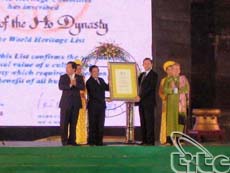The Ho Dynasty Citadel in central Thanh Hoa province received a UNESCO certificate of World Cultural Heritage status at a grand ceremony on June 16.
 The citadel was recognised as a World Cultural Heritage site on June 27 last year.
The citadel was recognised as a World Cultural Heritage site on June 27 last year.
UNESCO's Assistant Director-General for External Relations and Public Information Eric Falt presented the certificate to representatives of the Vietnam National Commission for UNESCO and Thanh Hoa province authorities, in the presence of National Assembly Chairman Nguyen Sinh Hung and senior Party and State officials of Vietnam as well as representatives from the diplomatic corps and foreign organisations.
Addressing the ceremony, National Assembly Chairman Nguyen Sinh Hung congratulated Thanh Hoa province on having an ancient architectural work honoured globally.
He said that the recognition requires Vietnam to conserve and promote cultural values of the citadel and other heritage sites in line with the Vietnam Heritage Law and the UN Convention Concerning the Protection of the World Cultural and Natural Heritage.
On this occasion, Thanh Hoa provincial Party's Committee launched a range of activities including an ethnic cultural festival, a photo contest and an exhibition of documents and artifacts relating to the Ho Dynasty Citadel. Special tours of the citadel are also organised for visitors to introduce heritage tourism potential in the province.
The Ho Dynasty Citadel was Vietnam's capital under the Ho Dynasty (1398-1407).
Located in Vinh Tien and Vinh Long communes in Vinh Loc district, the citadel measures 870m by 883m and was built within only three months, between January and March of 1397. It is the only one built entirely of stone in Vietnam and remained almost intact through ups and downs in history.
Also known as the Tay Do, An Ton, Tay Kinh or Tay Giai citadel, the ancient building is famous for being strategically located where it could be easily defended. The citadel is protected by a mountain range to the north, while the Ma River runs to its west and the Buoi River to its south, creating a huge natural moat.